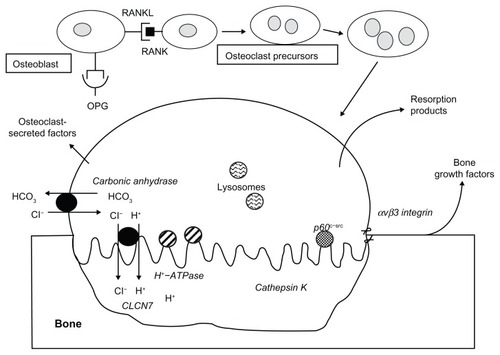Figures & data
Figure 1 Osteoblasts express a membrane protein, receptor activator of nuclear factor kappa-B ligand (RANKL), which plays a critical role in osteoclast differentiation, activation, and survival.
Notes: The binding of RANKL to its receptor, receptor activator of nuclear factor kappa-B, expressed in mononuclear hematopoietic precursors, initiates the processes that ultimately lead to the formation of multinucleate osteoclasts. Mature osteoclasts attach to bone surface to seal off an extracellular compartment, termed a “resorption lacuna,” in which mineralized bone matrix can be resorbed. The attachment of the osteoclast to bone is facilitated by podosomes containing filamentous actin and the alpha-v beta-3 integrin. The osteoclast forms a ruffled border at the apical membrane of the osteoclast, facing the resorption lacuna. Carbonic anhydrase II within the osteoclast generates a proton and bicarbonate from carbon dioxide and water. The proton is actively transported across the membrane of the ruffled border through the action of the osteoclast-specific vacuolar-type H+-ATPase “proton pump” to reduce the pH to about 4. Passive transport of chloride through a chloride channel coupled to the proton pump facilitates balancing the charge of ions across the membrane. The acid pH removes the bone mineral, exposing matrix proteins like type I collagen to be degraded by lysosomal enzymes such as cathepsin K that are secreted into the resorption lacuna. Osteoclast-secreted factors and growth factors released from bone matrix during resorption stimulate osteoblast proliferation, differentiation, and/or activity (see text). Bone resorption products are released into the systemic circulation.
